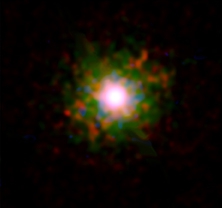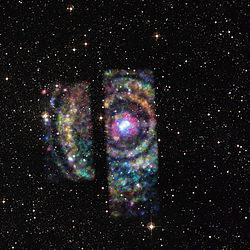| Observation data Epoch J2000 Equinox J2000 | |
|---|---|
| Constellation | Circinus |
| Right ascension | 15h 20m 40.85s [1] |
| Declination | −57° 10′ 00.1″ [1] |
| Apparent magnitude (V) | 21.40 [2] |
| Characteristics | |
| Spectral type | B5–A0 I [3] |
| Variable type | HMXB [4] |
| Astrometry | |
| Distance | 31000+2600 −3300 ly (9400+800 −1000 [5] pc) |
| Orbit [3] | |
| Period (P) | 16.68 ± 0.15 d |
| Eccentricity (e) | 0.45 ± 0.07 |
| Periastron epoch (T) | JD 2453473.8 ± 0.4 |
| Argument of periastron (ω) (secondary) | 2 ± 12° |
| Semi-amplitude (K1) (primary) | 25 ± 2 km/s |
| Other designations | |
| INTREF 645, 2U 1516-56, BR Cir, 2MASS J15204084-5710001 [4] | |
| Database references | |
| SIMBAD | data |
Circinus X-1 is an X-ray binary star system that includes a neutron star. Observation of Circinus X-1 in July 2007 revealed the presence of X-ray jets normally found in black hole systems; it is the first of the sort[ clarification needed ] to be discovered that displays this similarity to black holes. Circinus X-1 may be among the youngest X-ray binaries observed.


